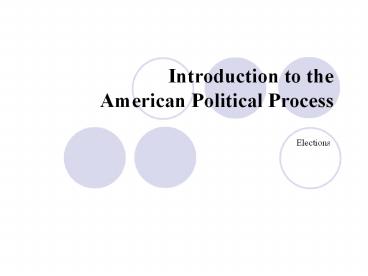Introduction to the - PowerPoint PPT Presentation
1 / 19
Title:
Introduction to the
Description:
Political Parties in American Politics. Parties serve goals of candidates ... Creating Momentum. CNN/USA Today Poll. Kerry. Dean. Money Raised. Money Spent ... – PowerPoint PPT presentation
Number of Views:18
Avg rating:3.0/5.0
Title: Introduction to the
1
Introduction to the American Political Process
Elections
2
Campaigns and Elections An Introduction
- Several topics in the next three lectures
- The spatial model revisited electoral
responsiveness - The mechanics of the process How do we choose
our leaders? - The campaign Strategy and tactics
- The role of the media
- Campaign financing
- How do people decide for whom to vote?
- The place of negative campaigning
3
The Spatial Model Revisited
?Apply to elections ?Electoral system matters
PR vs. Plurality rule? ?Plurality rule system
?One-dimensional policy space
?Single-peaked utility function ?
Majority rule ? Prediction candidate
convergence
4
Democratic Seats and Votes
Percent Seats
Percent Votes/SeatsPercent
Percent Votes
Year
5
Presidents, and House and Senate Means, 1st
Dimension of Joint Space
Regan Bush
Nixon
Ford
Liberal Conservative
Clinton
JFK
LBJ
Carter
House
Senate
Presidents
6
Wheres the convergence?
?Presidential candidates? ?Congressional
candidates? ?Why does the median voter theorem
fail? ?Primaries? ?Candidate reputation?
?Different distinct medians? ?Importance of
parties
7
Political Parties in American Politics
?Parties serve goals of candidates ?Parties
regulate competition for office ?Parties
avoid chaos in Congress ?Party in
government can lead to party in the
electorate ? Parties can coordinate action
across different levels of
government ?Perverse consequences
8
Campaigns and Elections
?The importance of elections ? Elections ensure
that government can be responsive to its
citizens ? Properties of elections legitimate
process ?Elections are regular ?Everyone
gets one vote ?Procedures are in place so we
can (usually) agree who won
9
Presidential Nominations
?Nominations A historical perspective ?How are
candidates selected? ?Primary elections
?Local caucuses
10
Money Raised
11
Money Spent
12
The Modern System
?Evolution over time ?1912-1924 The first
wave of primaries ?1924-1968 Party leader
centered politics ?1972-Today The second
wave of primaries
13
The Rise of Presidential Primaries
Percent of Republican Delegates
Percent of Republican Delegates
Percent of Delegates/Number of Primaries
Number of Republican Primaries
Year
14
Presidential Nomination
?Unintended consequences ?Frontloading
15
New Hampshire
?7th Smallest State ?2 million residents ?First
in the nation Primary ?2000 Turnout
?238,606 Republicans ?154,639 Democrats
16
The Dynamics of the Electoral Campaign
?Winnowing ?The Big Mo ?Election The
horserace ?Pre-Election Name recognition and
money ?The Horserace ?Creating Momentum
17
CNN/USA Today Poll
Kerry
Dean
18
Money Raised
19
Money Spent































